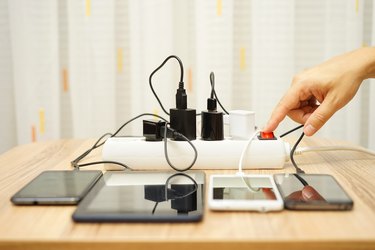
The battery is a cell phone's most important feature, yet few people think about its powerful role during everyday use. Quite simply, it provides hours of reliable power for portable use and can be recharged hundreds, even thousands, of times before its power fizzles out and a replacement is necessary. When charging a cell phone battery to full capacity, it is important to understand what technology is being implemented to maximize battery life and prevent damage.
Lithium Ion Technology
Video of the Day
An overwhelming majority of cell phone batteries use lithium-ion technology. Unlike previous generations of batteries, Li-ion batteries do not suffer from the "memory effect." This is when a battery "remembers" its charge level when it is unplugged, causing the internal circuitry to reset that level as its fully charged level, thus reducing its overall lifespan. Li-ion batteries, on the other hand, can be charged successfully at any level without reducing their life span.
Video of the Day
It is important to know that Li-ion batteries degrade over time. From the moment they are manufactured, they begin to lose power. Although it happens slowly, you have probably noticed how your 2-year-old cell phone will not hold a charge as well as when it was new. Excessive heat will accelerate the aging process drastically, so it is important to keep your Li-ion batteries cool, especially for long-term storage.
Battery Charge Levels
Quite simply, it is not possible to overcharge a cell phone battery. However, leaving it plugged in for more that 24 hours can cause it to overheat, thereby shortening its overall lifespan. Most Li-ion batteries and chargers contain internal circuitry that stops the charging when it hits 100 percent, but always unplug it after long charging intervals, just to be safe.